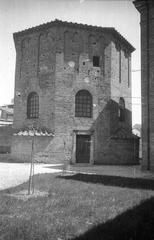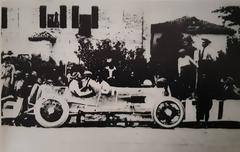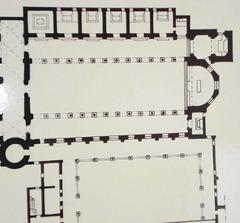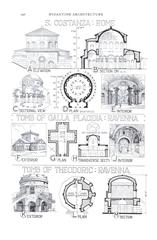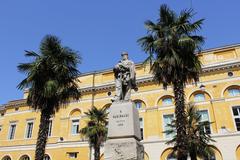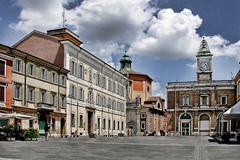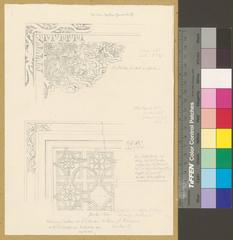Arian Baptistery Ravenna: Visiting Hours, Tickets, and Historical Significance
Date: 14/06/2025
Overview
The Arian Baptistery (Battistero degli Ariani) is a remarkable early Christian monument located in the heart of Ravenna, Italy. Erected in the late 5th to early 6th centuries CE under the patronage of King Theodoric the Great, it stands as a testament to the city’s religious, artistic, and political complexity during late antiquity. Its world-renowned dome mosaics and unique octagonal architecture offer profound insight into both the Arian Christian tradition and the broader context of Ravenna’s golden age as a crossroads of East and West (Wikipedia; Turismo Ravenna; UNESCO World Heritage Centre; RavennAntica).
Table of Contents
- Introduction
- Historical and Religious Context
- Architecture and Mosaics
- UNESCO World Heritage Status
- Visiting Information: Hours, Tickets, and Accessibility
- Visitor Experience: Tours, Tips, and Nearby Attractions
- Frequently Asked Questions (FAQ)
- Practical Recommendations
- Conclusion and Call to Action
- References
Introduction
The Arian Baptistery is one of Ravenna’s most significant historical sites, celebrated for its stunning mosaics and its role in reflecting the Ostrogothic kingdom’s religious identity. This guide provides a detailed overview of the baptistery’s origins, its artistic and theological significance, practical visitor information, and expert tips to help you make the most of your visit to Ravenna’s UNESCO-listed heritage.
Historical and Religious Context
Ostrogothic Ravenna and the Rise of Arianism
Following the collapse of the Western Roman Empire, Ravenna became the capital of the Ostrogothic Kingdom. Theodoric the Great, educated in Constantinople, ruled over a diverse population and adhered to Arian Christianity—a faith considered heretical by the mainstream Chalcedonian (Orthodox) Church. To accommodate religious differences, Theodoric pursued a policy of tolerance, commissioning separate worship spaces for the Arian community, including the Arian Baptistery and the nearby Arian Cathedral (now Basilica of Santo Spirito) (Wikipedia; Turismo Ravenna).
Religious Schism and Transformation
Arianism, which denied the full divinity of Christ, was widely practiced among the Ostrogoths and other Germanic tribes. The baptistery originally served the Ostrogothic court and their followers. With the Byzantine reconquest in the 6th century, Arian worship was suppressed, and the baptistery was reconsecrated for Orthodox use, dedicated to the Virgin Mary. This marked a critical transition in Ravenna’s religious landscape (Turismo Ravenna; nomads-travel-guide.com).
Architecture and Mosaics
Exterior and Structure
The baptistery is octagonal, a form symbolizing rebirth and common to early Christian baptisteries. Its brickwork is austere and characteristic of late antique Ravenna, with two horizontal bands, arched windows, and alternating small apses and flat sides. The building has sunk about 2.3 meters below street level due to centuries of subsidence (European Traveler; Medieval Mosaics).
Interior and Baptismal Font
Inside, a large octagonal marble font dominates the space, used for full-immersion baptisms. The ambulatory surrounding the font allowed processions, while the dome rests on a transition from a square base to an octagonal drum, a technique blending Roman and Byzantine influences.
Dome Mosaics: Iconography and Style
The dome mosaic is the baptistery’s artistic centerpiece. It depicts Christ’s baptism by John the Baptist in the Jordan River, with the river personified as a classical deity. The Holy Spirit descends as a dove, and the surrounding procession of the twelve apostles moves toward a jeweled throne (hetoimasia), symbolizing Christ’s anticipated return. The mosaic’s gold background and stylized figures reflect both local and Eastern Mediterranean artistic traditions (Medieval Mosaics; Turismo Ravenna).
Comparison to the Neonian Baptistery
The Arian and Neonian Baptisteries share similar iconography but differ in details reflecting theological distinctions. For example, the Arian mosaic features palm trees dividing the apostles and an inverted frieze orientation, possibly referencing Arian beliefs, though artistic conventions also played a role (Wikipedia).
UNESCO World Heritage Status
The Arian Baptistery is included in the collective UNESCO World Heritage listing “Early Christian Monuments of Ravenna,” recognized for:
- Criterion (i): Its dome mosaic is a masterpiece of early Christian art.
- Criterion (ii): It illustrates significant artistic and religious exchanges between West and East.
- Criterion (iii): It bears exceptional testimony to the Arian Christian tradition.
- Criterion (iv): It exemplifies a significant historical transition from Roman to Byzantine rule (UNESCO World Heritage Centre).
Visiting Information: Hours, Tickets, and Accessibility
Opening Hours (as of June 2025)
- Monday to Thursday: 9:00 am – 12:00 pm
- Friday to Sunday & holidays: 9:00 am – 12:00 pm and 2:00 pm – 5:00 pm
- Special extended hours: During summer and major events, hours may extend to 7:00 pm. Last admission is 30 minutes before closing (RavennAntica; Ravenna Mosaici).
Tickets
- Admission: Typically €3–€5 per person; combination tickets for multiple monuments are €12–€13.
- Discounts: Available for students, seniors, and children.
- Free Entry: On select days (e.g., first Sunday of the month and local holidays).
- Where to Buy: Onsite at the entrance or online via official tourism portals (RavennAntica).
Accessibility
- Mobility: The baptistery is partially below street level, with steps leading inside. There is no elevator or ramp, so wheelchair access is limited. Staff assistance is available for visitors with mobility concerns (TravelHoo).
- Facilities: No restrooms or cloakrooms on site; public facilities are nearby.
Visitor Experience: Tours, Tips, and Nearby Attractions
Guided Tours
- Guided walking or cycling tours, often lasting about three hours and including other UNESCO sites, are available.
- Audio guides and printed materials may be offered at the entrance but are limited; expert guides provide deeper context (TravelHoo).
Visitor Conduct and Photography
- Photography without flash is permitted for private use.
- Tripods, monopods, and selfie sticks are prohibited.
- Modest attire (shoulders and knees covered) is required out of respect for the sacred space (Ravenna Mosaici).
Tips for a Better Visit
- Timing: Early mornings or late afternoons are quieter.
- Duration: Allow 20–30 minutes for the baptistery; combine with other sites for a fuller experience.
- Nearby Sites: Neonian Baptistery, Basilica of San Vitale, Mausoleum of Galla Placidia, and Basilica of Sant’Apollinare Nuovo are all within walking distance.
- Souvenirs: Local shops nearby offer books and mosaic-themed gifts.
Getting There
- Located at Piazzetta degli Ariani, 48121 Ravenna RA, Italy, near the railway station and city center.
- Easily reached on foot, by public transport, or by bicycle (TravelHoo).
Frequently Asked Questions (FAQ)
Q: What are the Arian Baptistery opening hours?
A: Typically, 9:00 am – 12:00 pm Monday to Thursday; 9:00 am – 12:00 pm and 2:00 pm – 5:00 pm Friday to Sunday and holidays. Extended hours possible in summer.
Q: How much do tickets cost?
A: €3–€5 for the baptistery; combination tickets for multiple sites are €12–€13.
Q: Is the Arian Baptistery wheelchair accessible?
A: Access is limited due to steps and lack of ramps. Staff assistance is available.
Q: Are guided tours available?
A: Yes, via local providers. Booking in advance is recommended during busy periods.
Q: Can I take photographs inside?
A: Yes, without flash and subject to staff approval.
Q: What else can I visit nearby?
A: The Neonian Baptistery, Basilica of San Vitale, Mausoleum of Galla Placidia, and other UNESCO sites.
Practical Recommendations
- Best Time to Visit: Early morning or late afternoon, especially outside peak tourist months (April–October).
- Dress Code: Modest clothing is required.
- Facilities: Restrooms are available at nearby attractions.
- Accessibility: Note the steps and uneven floors; wear comfortable shoes.
- Duration: Allocate at least 20–30 minutes for your visit.
- Special Events: Check local event calendars for festivals or extended opening hours.
Conclusion and Call to Action
The Arian Baptistery stands as an enduring emblem of Ravenna’s rich religious and artistic heritage. Its distinctive mosaics and architecture illuminate early Christian theological debates and the multicultural fabric of late antique Italy. Whether you’re an art enthusiast, historian, or traveler, the baptistery offers an unforgettable window into a pivotal era.
Plan your visit by checking current hours and ticketing info through official sources. For an enhanced experience, consider joining a guided tour or exploring virtual resources. Embrace the opportunity to discover Ravenna’s extraordinary mosaic heritage and deepen your appreciation for this unique UNESCO World Heritage monument.
For the latest updates, guided tours, and cultural insights, download the Audiala app and follow Ravenna’s vibrant heritage scene on social media (Turismo Ravenna; RavennAntica; Ravenna Mosaici; UNESCO World Heritage Centre).
